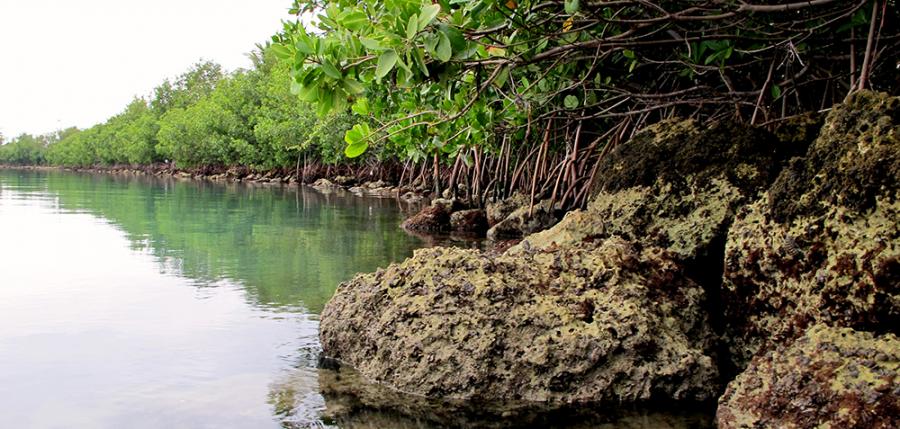
Imagine you’re visiting your grandparents’ oceanfront home for the first time since you were young. You take a careful seat on the water’s edge, your nostalgia interrupted by the sharp, unfamiliar rocks lining the shore. You’ve changed since your last visit—and so, it seems, has the landscape.
Many coastal regions have experienced similar transitions as a result of growing populations and accompanying economic development. Biscayne Bay, Florida is one such region. The area’s natural beauty has attracted more and more residents and visitors, which spurred the rapid urbanization of Miami and the surrounding area in the 20th century. The flood of people ushered in a slew of environmental impacts such as pollution, loss of habitat, and shoreline erosion over time. Although these impacts aren’t unique to this area, the threat they pose to the region’s natural resources are cause for concern.
Mangrove forests, known for their dense tangle of prop roots, are native to Biscayne Bay. The root systems trap and filter out sediment, making mangroves important for both coastline protection and providing habitat to a wide variety of aquatic life and shoreline birds. These unique habitats have in many places been degraded or destroyed by urban development. Restoration efforts have included living shoreline techniques (i.e., supplementing hard structures such as sea walls and retaining walls with mangrove trees) to stabilize the shoreline and to provide an environment for wildlife to utilize.
A study recently published in the peer-reviewed Bulletin of Marine Science by Joseph Peters of Portland State University, Lauren Yeager of the National Socio-Environmental Synthesis Center (SESYNC), and Craig Layman of North Carolina State University analyzed the ecological impacts of riprap installation (i.e., rock or other material used to armor shorelines against erosion) combined with mangrove plantings. They were specifically interested in the differences of fish assemblages between artificial riprap mangroves and natural mangroves in northern Biscayne Bay. The researchers found that overall, restored shorelines had the most species-rich fish communities, therefore demonstrating the potential to improve degraded shorelines and successfully support aquatic life.
They did, however, find a caveat. Riprap is not a one-size-fits-all solution.
“There are benefits to planting artificial mangroves—but the mangrove root structure is somewhat changed by the rocky riprap, and as a result the roots cannot perform many of their natural functions,” Peters explained. “We anticipated that there might be a difference in the fishes that utilize the riprap versus natural mangroves. But among certain fish species, it appears that riprap mangrove habitats don’t add any value. We think it’s because the artificial rock–root structure doesn’t provide equal protection for certain fishes against predators as compared to natural mangroves.”
Coastal communities are working to find ways to cope with shoreline degradation, prevent further damage from erosion, and design restoration projects in a sustainable way. Living shorelines are emerging as a preferred restoration method—their environmental benefits are plenty, and they’re often more adaptable to potential impacts associated with climate change. Since 1987, more than $11 million has been spent on coastal habitat restoration and exotic plant removal in Biscayne Bay alone.
Restoration can be expensive. But the economic costs may be a fair trade to prevent the total destruction of coastal shorelines, leaving generations to come without the important ecosystem services they provide. We’re at risk of losing more than our nostalgia—if we don’t look closer into restoration solutions, we’ll have bigger fish to fry.
The National Socio-Environmental Synthesis Center, funded through an award to the University of Maryland from the National Science Foundation, is a research center dedicated to accelerating scientific discovery at the interface of human and ecological systems. Visit us at www.sesync.org and follow us on Twitter at @SESYNC.
Top image: Riprap mangrove restoration, courtesy Joseph Peters.